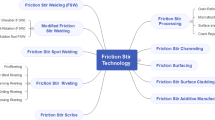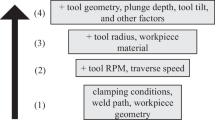Abstract
Friction Stir Processing (FSP) is becoming an acceptable technique for modifying the grain structure of sheet metals. One of the most important issues that hinder the widespread use of FSP is the lack of accurate models that can predict the resulting microstructure in terms of process parameters. Most of the work that has been done in the FSP field is experimental, and limited modeling activities have been conducted. In this work, an analytical model is presented that can predict the strain rate distribution and the deformation zone in the friction stir processed zone as a function of process parameters. In the model, the velocity fields within the processed zone are determined by incorporating the effects of both the shoulder and the pin of the tool on the material flow. This is achieved by introducing state variables and weight functions. The model also accounts for different interfacial conditions between the tool and the material. The effects of different process parameters and conditions on the velocity fields and strain rate distributions are discussed. The results clearly show that the model can successfully predict the shape of the deformation zone and that the predicted strain rate values are in good agreement with results reported in the literature.













Similar content being viewed by others
Abbreviations
- r :
-
Radial distance from the tool center (m)
- r p :
-
Pin radius (m)
- r s :
-
Shoulder radius (m)
- z :
-
Distance from top to bottom in the thickness direction (m)
- z o :
-
Pin height (m)
- θ:
-
The angle from the radial axis at the middle section of the tool (moving clockwise when looking from the top) (radians)
- ω:
-
Rotational speed of the tool (rad/s)
- v :
-
Translational speed of the tool (m/s)
- V material :
-
FS-processed material resultant velocity (m/s)
- V shoulder :
-
Shoulder resultant velocity (m/s)
- V pin :
-
Pin resultant velocity (m/s)
- η:
-
Material/pin state variable
- λ:
-
Material/shoulder state variable
- \(u_{{\rm (s)}\uptheta}\) :
-
Material velocity component caused by shoulder in the θ direction (m/s)
- \(u_{{\rm (s)}r}\) :
-
Material velocity component caused by shoulder in the r direction (m/s)
- \(u_{{\rm (p)}\uptheta}\) :
-
Material velocity component caused by pin in the θ direction (m/s)
- \(u_{{\rm (p)}r}\) :
-
Material velocity component caused by pin in the r direction (m/s)
- \(w_{{\rm(s)}\uptheta}\) :
-
Shoulder weight function in the θ direction
- \(w_{{\rm (s)}r}\) :
-
Shoulder weight function in the r direction
- \(w_{{\rm (p)}\uptheta}\) :
-
Pin weight function in the θ direction
- \(w_{{\rm(p)}r}\) :
-
Pin weight function in the r direction
- u θ :
-
Material resultant velocity component in the θ direction (m/s)
- u r :
-
Material resultant velocity component in the r direction (m/s)
- u z :
-
Material resultant velocity component in the z direction (m/s)
- \({\dot{\upvarepsilon}}_{\rm eff}\) :
-
Effective strain rate (1/s)
References
W. Thomas, E. Nicholas, J. Needham, M. Murch, P. Temlesmith, and C. Dawes, GB Patent Application No. 9125978.8, December 1991
Ma Z., Mishra R., Mahoney M. (2002) Superplastic deformation behaviour of friction stir processed 7075Al alloy. Acta Mater. 50:4419–4430
Su J., Nelson T., Sterling C. (2005) Friction stir processing of large-area bulk UFG aluminum alloys. Scripta Mater. 52:135–140
Khraisheh M., Darras B., Kalu P., Adams-Hughes M., Chandra N. (2005) Correlation between the microstructure and forces generated during friction stir processing of AA5052. Mater. Sci. Forum 475–479:3043–3046
Darras B., Khraisheh M., Abu-Farha F., Omar M. (2007) Friction stir processing of AZ31 commercial Magnesium alloy. J. Mater. Process. Technol. 191:77–81
Ulysse P. (2002) Three-dimensional modeling of friction stir-welding process. Int. J. Machine Tools Manuf. 42:1549–1557
Chang C., Lee C., Huang J. (2004) Relationship between grain size and Zener-Holloman parameter during friction stir processing in AZ31 Mg alloys. Scripta Mater. 51:509–514
Heurtier P., Desrayaud C., Montheillet F. (2002) A thermomechanical analysis of the friction stir welding process. Mater. Sci. Forum 396–402:1537–1542
Schmidt H., Hattel J., Wert J. (2004) An analytical model for the heat generation in friction stir welding. Modell. Simul. Mater. Sci. Eng. 12:143–157
W. Arbegast, Modeling Friction Stir Joining as a Metal Working Process, Hot Deformation of Aluminum Alloys III, TMS Annual Meeting, San Diego, CA, 2003, p 313–327
J. Schneider and A. Nunes, Thermo-Mechanical Processing in Friction Stir Welds, Friction Stir Welding and Processing II, Proceedings of a Symposia Sponsered by the Shaping and Forming Committee of the Materials Processing, TMS Annual Meeting, San Diego, CA, 2003, p 43–51
Nandan R., Roy G., Debroy T. (2006) Numerical simulation of three-dimensional heat transfer and plastic flow during friction stir welding. Metall. Mater. Trans. A 37A:1247–1259
Buffa G., Hua J., Shivpuri R., Fratini L. (2006) A continuum based fem model for friction stir welding-model development. Mater. Sci. Eng. A 419:389–396
Darras B., Omar M., Khraisheh M. (2007) Experimental thermal analysis of friction stir processing. Mater. Sci. Forum 539–543:3801–3806
L. Malvern, Introduction to the Mechanics of Continuous Media, Prentice-Hall, 1969, p 526.
Ericsson M., Jin L., Sandstrom R. (2007) Fatigue properties of friction stir overlap welds. Int. J. Fatigue 29:57–68
Hassan Kh., Norman A., Price D., Pragnell P. (2003) Stability of nugget zone grain structures in high strength Al-alloy friction stir welds during solution treatment. Acta Mater. 51:1923–1936
Acknowledgment
The support of the National Science Foundation, CAREER Award # DMI-0238712, is acknowledged.
Author information
Authors and Affiliations
Corresponding author
Rights and permissions
About this article
Cite this article
Darras, B., Khraisheh, M. Analytical Modeling of Strain Rate Distribution During Friction Stir Processing. J. of Materi Eng and Perform 17, 168–177 (2008). https://doi.org/10.1007/s11665-007-9179-z
Received:
Accepted:
Published:
Issue Date:
DOI: https://doi.org/10.1007/s11665-007-9179-z




